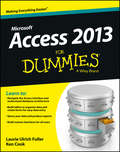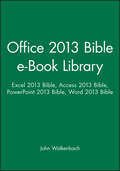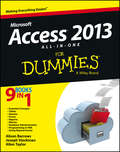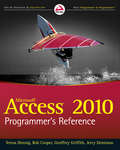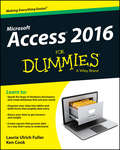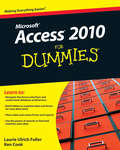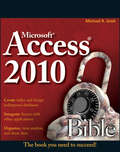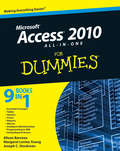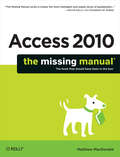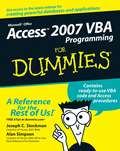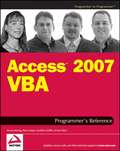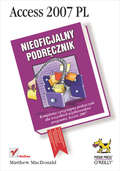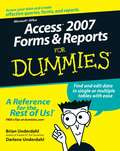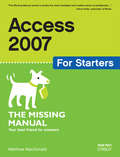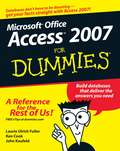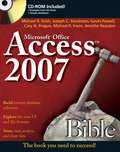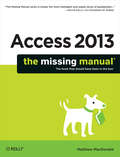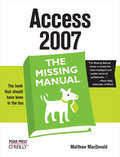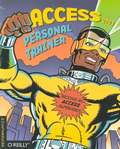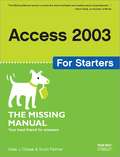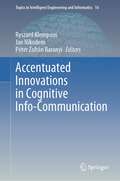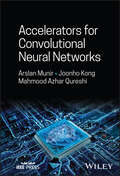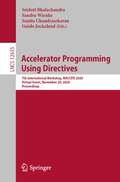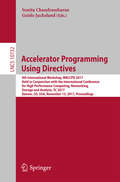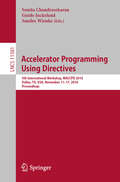- Table View
- List View
Access 2013 For Dummies
by Laurie A. Ulrich Ken CookThe easy guide to Microsoft Access returns with updates on the latest version! Microsoft Access allows you to store, organize, view, analyze, and share data; the new Access 2013 release enables you to build even more powerful, custom database solutions that integrate with the web and enterprise data sources. Access 2013 For Dummies covers all the new features of the latest version of Accessand serves as an ideal reference, combining the latest Access features with the basics of building usable databases. You'll learn how to create an app from the Welcome screen, get support for your desktop databases, and much more. Includes coverage of all the new features of Access 2013, including the updated interface Shows you how to create and share reports Features special videos and materials created by the authors to help reinforce the lessons included in the book Helps you build data analysis and interface tools for your specific needs Offers plenty of techniques and tips for solving common problems Access 2013 For Dummies provides you with access to the latest version of this database tool.
Access 2013 Bible
by Dick Kusleika Michael AlexanderA comprehensive reference to the updated and new features of Access 2013As the world's most popular database management tool, Access enables you to organize, present, analyze, and share data as well as build powerful database solutions. However, databases can be complex. That's why you need the expert guidance in this comprehensive reference. Access 2013 Bible helps you gain a solid understanding of database purpose, construction, and application so that whether you're new to Access or looking to upgrade to the 2013 version, this well-rounded resource provides you with a thorough look at everything Access can do. Explains how to create tables, manipulate datasheets, and work with multiple tablesTeaches you how to apply the seven-step design method to build databases that are tailored to your needsCovers building forms with wizards, creating bound and unbound forms, and adding data validationShows you ways to automate query parameters, create functions and subroutines, and add programmed error routinesFeatures a bonus website with content that contains all source code from the book as well as bonus shareware, freeware, trial, demo, and evaluation programsIf you are looking for a comprehensive book on all things Access, look no further than Access 2013 Bible.
Access 2013 All-in-One For Dummies
by Joseph C. Stockman Alison Barrows Allen G. TaylorGet started with the new Access 2013 with this impressive all-in-one reference!Microsoft Access allows you to store, organize, view, analyze, and share data; the new release enables you to build even more powerful, custom database solutions that integrate with the web and enterprise data sources. This compilation of nine indispensible minibooks is exactly what you need to get up to speed on the latest changes to Access. This easy-to-understand resource provides both new and experienced Access users with invaluable advice for connecting Access to SQL Server, manipulating data locally, getting up to speed on the latest features of Access 2013, creating queries and macros, and much more. From the basics to advanced functions, this book is what you need to make Access more accessible. Shows you how to store, organize, view, analyze, and share data using Access 2013Includes nine minibooks that cover such topics as database design, tables, queries, forms, reports, macros, database administration, securing data, programming with Visual Basic for Applications (VBA), and using Access with the web Helps you build database solutions that integrate with the web and other enterprise data solutionsOffers plenty of techniques, tips, and tricks to help you get the most out of Access This all-in-one guide offers you access to all things Access 2013!
Access 2010 Programmer's Reference
by Teresa Hennig Rob Cooper Geoffrey L. Griffith Jerry DennisonA comprehensive guide to programming for Access 2010 and 2007 Millions of people use the Access database applications, and hundreds of thousands of developers work with Access daily. Access 2010 brings better integration with SQL Server and enhanced XML support; this Wrox guide shows developers how to take advantage of these and other improvements. With in-depth coverage of VBA, macros, and other programming methods for building Access applications, this book also provides real-world code examples to demonstrate each topic. Access 2010 Programmer's Referenceis a comprehensive guide to the best-of-breed techniques for programming Access applications. Coverage Includes: Introduction to Microsoft Access 2010 New Features Upgrading and Converting to Access 2010 Macros in Access 2010 Using the VBA Editor VBA Basics Using VBA in Access Creating Classes in VBA Extending VBA with APIs Working with the Windows Registry Using DAO to Access Data Using ADO to Access Data Using SQL with VBA Using VBA to Enhance Forms Enhancing Reports with VBA Customizing the Ribbon Customizing the Office Backstage Working with Office 2010 Working with SharePoint Working with . NET Building Client-Server Applications with Access The Access 2010 Templates Access Runtime Deployment Database Security Access 2010 Security Features
Access 2010 For Dummies
by Laurie Ulrich Fuller Ken CookA friendly, step-by-step guide to the Microsoft Office database applicationAccess may be the least understood and most challenging application in the Microsoft Office suite. This guide is designed to help anyone who lacks experience in creating and managing a database learn to use Access 2010 quickly and easily.In the classic For Dummies tradition, the book provides an education in Access, the interface, and the architecture of a database. It explains the process of building a database, linking information, sharing data, generating reports, and much more.As the Microsoft Office database application, Access may be the least understood and most challenging part of the Office suiteAccess 2010 For Dummies walks newcomers through building and using their first databaseCovers linking information in a database, setting relationships, modeling data, and building tablesExplores how to extract data from Access and get specific answers, create forms, and export data in reportsA section for more experienced users looks at analyzing errors and creating an interfaceFully updated for the newest version, Access 2010 For Dummies gets new Access users up to speed and helps veterans get the most from the Office database application.
Access 2010 For Dummies
by Laurie A. Ulrich Ken CookA friendly, step-by-step guide to the Microsoft Office database application Access may be the least understood and most challenging application in the Microsoft Office suite. This guide is designed to help anyone who lacks experience in creating and managing a database learn to use Access 2010 quickly and easily. In the classic For Dummies tradition, the book provides an education in Access, the interface, and the architecture of a database. It explains the process of building a database, linking information, sharing data, generating reports, and much more. As the Microsoft Office database application, Access may be the least understood and most challenging part of the Office suite Access 2010 For Dummies walks newcomers through building and using their first database Covers linking information in a database, setting relationships, modeling data, and building tables Explores how to extract data from Access and get specific answers, create forms, and export data in reports A section for more experienced users looks at analyzing errors and creating an interface Fully updated for the newest version, Access 2010 For Dummies gets new Access users up to speed and helps veterans get the most from the Office database application.
Access 2010 Bible
by Michael R. GrohThe expert guidance you need to get the most out of Access 2010Get the Access 2010 information you need to succeed with this comprehensive reference. If this is your first encounter with Access, you'll appreciate the thorough attention to database fundamentals and terminology. If you're familiar with earlier versions, you can jump right into Access 2010 enhancements such as the new Access user interface and wider use of XML and Web services.Takes you under the hood of Microsoft Access 2010, the database application included with Microsoft Office 2010Explores the latest enhancements, such as a new user interface and wider use of XML and Web services; also, how to exchange data with Word, Excel, PowerPoint, and other Office appsCovers how to create tables, manipulate datasheets, and work with multiple tablesExplains the seven database objects and how to use a seven-step design method to build a database tailored to your needsShows you how to build forms, use Visual Basic and the VBA Editor, automate query parameters, create functions and subroutines, use XML to create data access pages, and moreIncludes a CD with all source code from the book and working examples, plus bonus shareware, freeware, trial, demo and evaluation programs that work with or enhance Microsoft OfficeYou'll want to keep this soup-to-nuts Access reference close at hand!Note: CD-ROM/DVD and other supplementary materials are not included as part of eBook file.
Access 2010 All-in-One For Dummies
by Margaret Levine Young Alison Barrows Joseph C. StockmanThe all-in-one reference to all aspects of Microsoft Access 2010 If you want to learn Microsoft Access inside and out, the nine minibooks in this easy-access reference are exactly what you need. Read the book cover to cover, or jump into any of the minibooks for the instruction and topics you need most. Learn how to connect Access to SQL Server, manipulate your data locally, use nifty new features from Office 2010 such as the enhanced Ribbon, create queries and macros like a champ, and much more. From the basics to advanced functions, it's what you need to make Access more accesssible. Shows you how to store, organize, view, analyze, and share data using Microsoft Access 2010, the database application included with Microsoft Office 2010 Includes nine minibooks that cover such topics as database design, tables, queries, forms, reports, macros, database administration, securing data, programming with Visual Basic for Applications (VBA), and using Access with the Web Helps you build database solutions that integrate with the Web and other enterprise data sources Offers plenty of techniques, tips, and tricks to help you get the most out of Access This all-in-one guide contains everything you need to start power-using Access 2010!
Access 2010: The Missing Manual (The\missing Manual Ser.)
by Matthew MacdonaldGo from Access novice to true master with the professional database design tips and crystal-clear explanations in this book. You'll learn all the secrets of this powerful database program so you can use your data in creative ways -- from creating product catalogs and publishing information online to producing invoices and reports. Build a database with ease. Store information to track numbers, products, documents, and more Customize the interface. Build your own forms to make data entry a snap Find what you need fast. Search, sort, and summarize huge amounts of information Put your data to use. Turn raw info into printed reports with attractive formatting Share your data. Collaborate online with SharePoint and the brand-new Access web database Dive into Access programming. Get tricks and techniques to automate common tasks Create rich data connections. Build dynamic links with SQL Server, SharePoint, and other systems
Access 2007 VBA Programming For Dummies
by Alan Simpson Joseph C. StockmanIf you've been using Access for a while, you're probably aware of its power and potential and itching to take advantage of both. Access 2007 VBA Programming For Dummies takes you beyond forms and reports and shows you how to use VBA to create killer Access databases and applications. This gentle introduction to VBA programming covers everything you need to get started, including:Basic programming skills and conceptsExplanations of modules, procedures, objects, and argumentsAccess-unique programming activities, including SQL and recordsetsHow to use the Visual Basic editorCreating dialog boxes, lists, drop-down menus, and functionsIntegrating with other Office applicationsReady-to-use VBA code examples to type in or copy and paste from the WebCompletely revised to reflect all changes found in Microsoft Access 2007, Access 2007 VBA Programming For Dummies gives you access to Access like you've never had it before.
Access 2007 VBA Programmer's Reference
by Teresa Hennig Rob Cooper Geoffrey Griffith Armen SteinAccess 2007 VBA Programmer's Reference covers a wide spectrum of programming topics relevant to Access. Although it assumes the reader has some familiarity with VBA programming language, it begins with a brief introduction to VBA. And to help you leverage the tools that Access provides, a chapter highlights the new features in Microsoft Office Access 2007 -- including new wizards and GUI (graphical user interface) elements that previously required VBA code, as well as new VBA features. The book also discusses how to create and name variables, how to use Data Access Object (DAO) and ActiveX Data Object (ADO) to manipulate data both within Access and within other applications, proper error handling techniques, and advanced functions such as creating classes and using APIs. Key new objects such as using Macros and the Ribbon are explored, too, as are forms and reports, the two most powerful tools for working with and displaying data. Working with other applications is covered extensively both in a general nature and for working specifically with Microsoft Office applications, Windows SharePoint Services, and SQL Server. Of course, this book wouldn't be complete without discussing security issues and the Developer Extensions.
Access 2007 PL. Nieoficjalny podr?cznik
by Matthew MacdonaldKompletny i przyst?pny podr?cznik dla wszystkich u?ytkowników programu Access 2007 Chcesz wydajnie zarz?dza? informacjami w ma?ej lub ?redniej firmie? Chcesz dowiedzie? si?, które funkcje Accessa 2007 znacznie u?atwiaj? prac?, a z których lepiej nie korzysta?? Chcesz nauczy? si? przygotowywa? wygodne interfejsy do obs?ugi baz danych? Zarz?dzanie danymi to zadanie, do którego komputery nadaj? si? wprost idealnie, a Microsoft Access to jeden z najlepszych systemów do obs?ugi relacyjnych baz danych w ma?ych i ?rednich firmach, umo?liwiaj?cy b?yskawiczne tworzenie graficznych interfejsów u?ytkownika i efektywne korzystanie ze z?o?onych informacji. Najnowsza wersja tego systemu, Access 2007, udost?pnia ca?kowicie zmieniony, bardziej intuicyjny interfejs, usprawniony silnik bazodanowy, narz?dzia do szybkiego tworzenia formularzy i raportów oraz wiele innych nowych funkcji, dzi?ki którym b?dziesz móg? ?atwiej i bardziej wydajnie zarz?dza? danymi w swojej firmie. Ksi??ka "Access 2007. Nieoficjalny podr?cznik" zawiera szczegó?owe instrukcje i wskazówki dotycz?ce korzystania z funkcji Accessa. Dzi?ki niej dowiesz si? wszystkiego, czego potrzebujesz do efektywnego zarz?dzania bazami danych za pomoc? tej aplikacji. Poznasz interfejs i najwa?niejsze funkcje Accessa, a tak?e techniki szybkiego tworzenia baz danych. Nauczysz si? sortowa?, przeszukiwa? i analizowa? informacje, manipulowa? danymi za pomoc? kwerend, przygotowywa? raporty oraz tworzy? wygodne interfejsy u?ytkownika. Zobaczysz te?, jak zautomatyzowa? ?mudne zadania za pomoc? makr i prostych programów w j?zyku Visual Basic. Tworzenie baz danych Sortowanie, wyszukiwanie i filtrowanie informacji Z??czanie danych za pomoc? relacji Stosowanie kwerend do manipulowania danymi Generowanie raportów Przygotowywanie interfejsu u?ytkownika Programowanie w aplikacji Access Wspó?dzielenie baz danych Komunikacja z SQL Server Poznaj tajniki aplikacji Access 2007 i efektywnie zarz?dzaj danymi w swojej firmie.
Access 2007 Forms and Reports For Dummies
by Darlene Underdahl Brian UnderdahlDo you have tons and tons of data on your computer but you're not quite sure how to make heads or tails of them--or even organize them? Are you using Access as spreadsheet rather than what it was really meant for? If you have trouble finding meaning in your data, then Access 2007 Forms & Reports for Dummies let you discover the wonders of this highly useful program.This no-nonsense guide gets right down to business by showing you the easy way to use this powerful tool. It gets you started with selective, targeted queries; forms that improve efficiency; and reports that communicate--while sparing you of any fancy language. This hands-on guide features clear, concise instructions that show you how to:Orient yourself with forms and reportsCreate and modify queriesBuild and edit formsDesign and update reportsTroubleshoot queries, forms, and reportsMake your forms usefulAdd multiple tables to formsAdd finishing touches to reportsThanks to the included references, Web sites, and informative tips, putting your data to good use has never been easier. You'll even add some pizzazz to your reports with handy suggestions on ways to wow your viewers. With Access 2007 Forms & Reports for Dummies, you will be creating effective queries, forms, and reports in no time!
Access 2007 for Starters: The Missing Manual
by Matthew MacdonaldThis fast-paced book teaches you the basics of Access 2007 so you can start using this popular database program right away. You'll learn how to work with Access' most useful features to design databases, maintain them, search for valuable nuggets of information, and build attractive forms for quick-and-easy data entry. The new Access is radically different from previous versions, but with this book, you'll breeze through the new interface and its timesaving features in no time with:Clear explanations Step-by-step instructions Lots of illustrations Larger type Plenty of friendly advice Ideal for small businesses and households, Access runs on PCs and manages large stores information, including numbers, pages of text, and pictures -- everything from a list of family phone numbers to an enormous product catalog. Unfortunately, each new version of the program crammed in yet another set of features -- so many that even the pros don't know where to find them all. Access 2007 breaks the mold: Microsoft changed the user interface by designing a tabbed toolbar that makes features easy to locate. One thing that hasn't improved is Microsoft's documentation. Even if you find the features you need, you still may not know what to do with them. Access 2007 for Starters: The Missing Manual is the perfect primer for small businesses with no techie to turn to, as well as those who want to organize household and office information.
Access 2007 For Dummies
by John Kaufeld Laurie Ulrich Fuller Ken CookReduce stress with timesaving database shortcutsExplore database basics and build tables and reports that corral your dataAccess has undergone an extreme makeover! Whether you've used one of the older versions or this is your first exposure to Access, here's where you'll find the essentials you need to make this database system work for you. Cruise around the new interface, team up Access with other Office applications, use wizards to automate your work, and much more.Discover how toCreate a new Access databaseImport and export dataBuild forms for efficient data entrySearch tables for specific dataConstruct custom reportsCustomize your database navigation
Access 2007 Bible
by Gavin Powell Jennifer Reardon Cary N. Prague Joseph C. Stockman Michael R. Groh Michael R. Irwin"I recommend this book for anyone who wants a strong foundation in Access."--Jeff Lenamon, CIBC World MarketsUpdated edition with exciting new Access 2007 features!Harness the power of Access 2007 with the expert guidance in this comprehensive reference. Beginners will appreciate the thorough attention to database fundamentals and terminology. Experienced users can jump right into Access 2007 enhancements like the all-new user interface and wider use of XML and Web services. Each of the book's six parts thoroughly focuses on key elements in a logical sequence, so you have what you need, when you need it. Designed as both a reference and a tutorial, Access 2007 Bible is a powerful tool for developers needing to make the most of the new features in Access 2007.Build Access tables using good relational database techniquesConstruct efficient databases using a five-step design methodDesign efficient data-entry and data display formsUtilize the improved Access report designerUse Visual Basic(r) for Applications and the VBA Editor to automate applicationsBuild and customize Access 2007 ribbonsSeamlessly exchange Access data with SharePoint(r)Employ advanced techniques such as the Windows(r) API and object-oriented programmingAdd security and use data replication in your Access applicationsWhat's on the CD-ROM?Follow the examples in the book chapter by chapter using the bonus materials on the CD-ROM. You'll find separate Microsoft Access database files for each chapter and other working files, includingAll the examples and databases used in the book, including database files, images, data files in various formats, and icon files used in the book's examplesA complete sample application file, including queries, reports, objects, and modules, that you can use as a referenceSee the CD-ROM appendix for details and complete system requirements.Note: CD-ROM/DVD and other supplementary materials are not included as part of eBook file.
Access 2007: The Missing Manual (The\missing Manual Ser.)
by Matthew MacdonaldCompared to industrial-strength database products such as Microsoft's SQL Server, Access is a breeze to use. It runs on PCs rather than servers and is ideal for small- to mid-sized businesses and households. But Access is still intimidating to learn. It doesn't help that each new version crammed in yet another set of features; so many, in fact, that even the pros don't know where to find them all. Access 2007 breaks this pattern with some of the most dramatic changes users have seen since Office 95. Most obvious is the thoroughly redesigned user interface, with its tabbed toolbar (or "Ribbon") that makes features easy to locate and use. The features list also includes several long-awaited changes. One thing that hasn't improved is Microsoft's documentation. To learn the ins and outs of all the features in Access 2007, Microsoft merely offers online help. Access 2007: The Missing Manual was written from the ground up for this redesigned application. You will learn how to design complete databases, maintain them, search for valuable nuggets of information, and build attractive forms for quick-and-easy data entry. You'll even delve into the black art of Access programming (including macros and Visual Basic), and pick up valuable tricks and techniques to automate common tasks -- even if you've never touched a line of code before. You will also learn all about the new prebuilt databases you can customize to fit your needs, and how the new complex data feature will simplify your life. With plenty of downloadable examples, this objective and witty book will turn an Access neophyte into a true master.
Access 2007: The Missing Manual (Missing Manual)
by Matthew MacdonaldCompared to industrial-strength database products such as Microsoft's SQL Server, Access is a breeze to use. It runs on PCs rather than servers and is ideal for small- to mid-sized businesses and households. But Access is still intimidating to learn. It doesn't help that each new version crammed in yet another set of features; so many, in fact, that even the pros don't know where to find them all. Access 2007 breaks this pattern with some of the most dramatic changes users have seen since Office 95. Most obvious is the thoroughly redesigned user interface, with its tabbed toolbar (or "Ribbon") that makes features easy to locate and use. The features list also includes several long-awaited changes. One thing that hasn't improved is Microsoft's documentation. To learn the ins and outs of all the features in Access 2007, Microsoft merely offers online help.Access 2007: The Missing Manual was written from the ground up for this redesigned application. You will learn how to design complete databases, maintain them, search for valuable nuggets of information, and build attractive forms for quick-and-easy data entry. You'll even delve into the black art of Access programming (including macros and Visual Basic), and pick up valuable tricks and techniques to automate common tasks -- even if you've never touched a line of code before. You will also learn all about the new prebuilt databases you can customize to fit your needs, and how the new complex data feature will simplify your life. With plenty of downloadable examples, this objective and witty book will turn an Access neophyte into a true master.
Access 2003 Personal Trainer
by Customguide IncAs the most popular database management program on the market, Microsoft Access didn't need much improvement. But with the release of Access 2003, Microsoft managed to further enhance the way people organize, access, and share information. In this new version, Access is more capable than ever, thanks to additional features like automatic error checking, automatic property updating, and the expanded ability to import, export, and work with Extensible Markup Language (XML) data files. The number of features it offers is truly impressive--and potentially daunting. Anyone baffled by the multitude of features and functionality in Microsoft Access can get up to speed quickly with the help of Access 2003 Personal Trainer . Part of our new Personal Trainer Series, this book lets people of any technical level learn exactly what they need to know at their own pace. Unlike many consumer software tutorials that dumb down the material or present it in a confusing fashion, this book is written in a non-technical and engaging style that readers find fun, easy, and informative. This book will not only help existing users, but those who received Access as part of Microsoft Office and are now ready to dip their toe in the water. It starts with Access fundamentals and then moves on to tables, fields, queries, forms, reports, macros, and advanced topics like linking information from an external source. To best guide learning, Access 2003 Personal Trainer includes detailed diagrams, dozens of task-oriented lessons, and a fully interactive training simulation CD--everything you need to become an Access pro.
Access 2003 for Starters: Exactly What You Need to Get Started (Missing Manual)
by Scott Palmer Kate J. ChaseMaybe you got Access as part of Microsoft Office and wonder what it can do for you and your household; maybe you're a small business manager and don't have a techie on staff to train the office in Microsoft Access. Regardless, you want to quickly get your feet wet--but not get in over your head--and Access 2003 for Starters: The Missing Manual is the book to make it happen.Far more than a skimpy introduction but much less daunting than a weighty tech book, Access 2003 for Starters: The Missing Manual demystifies databases and explains how to design and create them with ease. It delivers everything you need--and nothing you don't--to use Access right away. It's your expert guide to the Access features that are most vital and most useful, and it's your trusted advisor on the more in-depth features that are best saved for developers and programmers.Access is sophisticated and powerful enough for professional developers but easy and practical enough for everyday users like you. This Missing Manual explains all the major features of Access 2003, including designing and creating databases, organizing and filtering information, and generating effective forms and reports.Bestselling authors, database designers, and programmers Scott Palmer, Ph.D., and Kate Chase are your guides for putting the world's most popular desktop data management program to work. Their clear explanations, step-by-step instructions, plenty of illustrations, and timesaving advice help you get up to speed quickly and painlessly.Whether you're just starting out or you know you've been avoiding aspects of the program and missing out on much of what it can do, this friendly, witty book will gently immerse you in Microsoft Access. Keep it handy, as you'll undoubtedly refer to it again and again.
Accentuated Innovations in Cognitive Info-Communication (Topics in Intelligent Engineering and Informatics #16)
by Ryszard Klempous Jan Nikodem Péter Zoltán BaranyiConsidering the emergence of artificial intelligence, virtual and augmented reality, 3D video and television, and holography, it is logical that we should also begin to create applications and businesses driven by these technologies. The 12 chapters of Accentuated Innovations in Cognitive Info-Communication focus on the research and development of state-of-the-art information in Cognitive Info-Communication. This interdisciplinary research area has emerged as a synergy between Info-Communication and Cognitive Sciences. It presents a synthetic, holistic combination of coherent technologies that will become increasingly important in the coming decade. It is a teaching and reference guide for VR, robotics, virtual classrooms and institutions, and medicine at the undergraduate and postgraduate levels. The discussed book is an immersive learning experience for students and teachers worldwide. In addition, it applies to other fields such as healthcare, performing arts, and television.
Accelerators for Convolutional Neural Networks
by Arslan Munir Joonho Kong Mahmood Azhar QureshiAccelerators for Convolutional Neural Networks Comprehensive and thorough resource exploring different types of convolutional neural networks and complementary accelerators Accelerators for Convolutional Neural Networks provides basic deep learning knowledge and instructive content to build up convolutional neural network (CNN) accelerators for the Internet of things (IoT) and edge computing practitioners, elucidating compressive coding for CNNs, presenting a two-step lossless input feature maps compression method, discussing arithmetic coding -based lossless weights compression method and the design of an associated decoding method, describing contemporary sparse CNNs that consider sparsity in both weights and activation maps, and discussing hardware/software co-design and co-scheduling techniques that can lead to better optimization and utilization of the available hardware resources for CNN acceleration. The first part of the book provides an overview of CNNs along with the composition and parameters of different contemporary CNN models. Later chapters focus on compressive coding for CNNs and the design of dense CNN accelerators. The book also provides directions for future research and development for CNN accelerators. Other sample topics covered in Accelerators for Convolutional Neural Networks include: How to apply arithmetic coding and decoding with range scaling for lossless weight compression for 5-bit CNN weights to deploy CNNs in extremely resource-constrained systems State-of-the-art research surrounding dense CNN accelerators, which are mostly based on systolic arrays or parallel multiply-accumulate (MAC) arrays iMAC dense CNN accelerator, which combines image-to-column (im2col) and general matrix multiplication (GEMM) hardware acceleration Multi-threaded, low-cost, log-based processing element (PE) core, instances of which are stacked in a spatial grid to engender NeuroMAX dense accelerator Sparse-PE, a multi-threaded and flexible CNN PE core that exploits sparsity in both weights and activation maps, instances of which can be stacked in a spatial grid for engendering sparse CNN accelerators For researchers in AI, computer vision, computer architecture, and embedded systems, along with graduate and senior undergraduate students in related programs of study, Accelerators for Convolutional Neural Networks is an essential resource to understanding the many facets of the subject and relevant applications.
Accelerator Programming Using Directives: 7th International Workshop, WACCPD 2020, Virtual Event, November 20, 2020, Proceedings (Lecture Notes in Computer Science #12655)
by Sridutt Bhalachandra Sandra Wienke Sunita Chandrasekaran Guido JuckelandThis book constitutes the proceedings of the 7th International Workshop on Accelerator Programming Using Directives, WACCPD 2020, which took place on November 20, 2021. The workshop was initially planned to take place in Atlanta, GA, USA, and changed to an online format due to the COVID-19 pandemic.WACCPD is one of the major forums for bringing together users, developers, and the software and tools community to share knowledge and experiences when programming emerging complex parallel computing systems. The 5 papers presented in this volume were carefully reviewed and selected from 7 submissions. They were organized in topical sections named: OpenMP; OpenACC; and Domain-specific Solvers.
Accelerator Programming Using Directives: 4th International Workshop, WACCPD 2017, Held in Conjunction with the International Conference for High Performance (9783319748962 #10732)
by Sunita Chandrasekaran Guido JuckelandThis book constitutes the refereed post-conference proceedings of the 4th International Workshop on Accelerator Programming Using Directives, WACCPD 2017, held in Denver, CO, USA, in November 2017. <P><P> The 9 full papers presented have been carefully reviewed and selected from 14 submissions. The papers share knowledge and experiences to program emerging complex parallel computing systems. They are organized in the following three sections: applications; environments; and program evaluation.
Accelerator Programming Using Directives: 5th International Workshop, WACCPD 2018, Dallas, TX, USA, November 11-17, 2018, Proceedings (Lecture Notes in Computer Science #11381)
by Sunita Chandrasekaran Guido Juckeland Sandra WienkeThis book constitutes the refereed post-conference proceedings of the 5th International Workshop on Accelerator Programming Using Directives, WACCPD 2018, held in Dallas, TX, USA, in November 2018. The 6 full papers presented have been carefully reviewed and selected from 12 submissions. The papers share knowledge and experiences to program emerging complex parallel computing systems. They are organized in the following three sections: applications; using openMP; and program evaluation.
